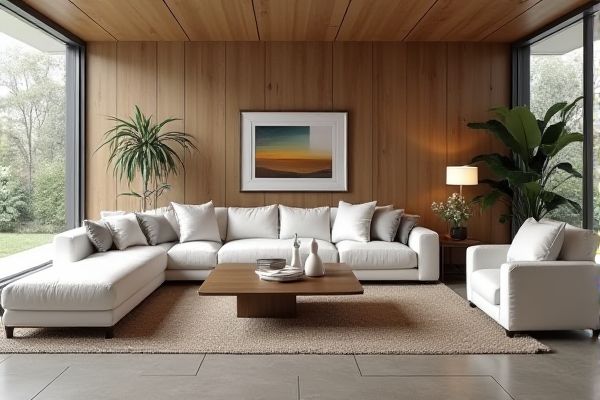
Resin furniture offers lightweight durability and weather resistance, making it ideal for outdoor use, while metal furniture provides strength and a sleek appearance but may require maintenance to prevent rust. Discover which material best suits Your needs by exploring the detailed comparison in the rest of this article.
Table of Comparison
| Feature | Resin Furniture | Metal Furniture |
|---|---|---|
| Material Composition | Synthetic polymer resin | Steel, aluminum, or iron alloys |
| Durability | Weather-resistant, rust-proof | Highly durable, prone to rust without coating |
| Weight | Lightweight and easy to move | Heavier and more stable |
| Maintenance | Low maintenance, easy to clean | Requires periodic rust prevention and repainting |
| Aesthetic Options | Variety of colors and styles | Classic industrial look, limited finishes |
| Cost | Affordable, budget-friendly | Higher initial investment |
| Comfort | Generally more ergonomic and comfortable | May require cushions for comfort |
| Environmental Impact | Less eco-friendly, non-biodegradable | Recyclable, longer lifespan |
Introduction to Resin and Metal Furniture
Resin furniture offers lightweight durability and resistance to weather, making it ideal for outdoor use, while metal furniture provides superior strength and a sleek, modern aesthetic. Your choice depends on your need for portability, maintenance preferences, and style, as resin materials are easy to clean and metal often requires rust protection. Both materials are popular for patios and gardens, with resin often mimicking wood or wicker textures and metal showcasing industrial or contemporary designs.
Material Composition and Properties
Resin furniture is crafted from synthetic polymers, offering lightweight durability, weather resistance, and stain-proof qualities ideal for outdoor use. Metal furniture, typically made from aluminum, steel, or wrought iron, provides superior strength, structural stability, and longevity but may require protective coatings to prevent rust and corrosion. The choice between resin and metal materials depends on factors like maintenance, weight, and environmental exposure.
Durability and Strength Comparison
Resin furniture offers excellent resistance to weather elements, making it less prone to rust, corrosion, and cracking under UV exposure, while maintaining flexibility that reduces breakage. Metal furniture, typically made from aluminum or steel, boasts superior strength and weight-bearing capacity but can suffer from rust and require protective coatings to ensure long-term durability. Selecting between resin and metal depends on the environment and usage, with resin favored for moisture-prone areas and metal preferred for maximum structural support.
Weather Resistance and Outdoor Suitability
Resin furniture offers superior weather resistance due to its natural ability to withstand moisture, UV rays, and temperature fluctuations without rusting or fading, making it ideal for outdoor use. Metal furniture, while durable, often requires protective coatings to prevent rust and corrosion when exposed to rain and humidity, potentially reducing its longevity in harsh weather conditions. Choosing resin furniture ensures low maintenance and prolonged outdoor suitability, especially in climates with frequent rain or intense sunlight.
Design Versatility and Aesthetic Appeal
Resin furniture offers exceptional design versatility, allowing for intricate shapes, vibrant colors, and realistic textures that mimic natural materials like wood and stone, enhancing aesthetic appeal in various settings. Metal furniture provides a sleek, modern look with clean lines and a variety of finishes such as matte, glossy, or powder-coated, delivering durability alongside contemporary style. You can select resin for creative, customizable designs or metal for minimalist, industrial elegance, depending on your aesthetic preferences and functional needs.
Maintenance and Cleaning Requirements
Resin furniture requires minimal maintenance, needing only regular wiping with mild soap and water to prevent dirt buildup and fading from UV exposure. Metal furniture often demands more upkeep, including periodic inspections for rust, repainting, and protection against corrosion, especially in humid or coastal environments. You can easily maintain resin furniture for a clean, durable outdoor setup without the hassle of extensive treatments needed for metal pieces.
Cost and Affordability Analysis
Resin furniture typically offers a more cost-effective solution compared to metal furniture, with prices often 30-50% lower due to cheaper materials and manufacturing processes. Metal furniture, while generally more expensive upfront, provides greater durability and longevity, potentially reducing replacement costs over time. Your choice should balance initial affordability with long-term value, considering resin for budget-friendly options and metal for sustained investment.
Eco-friendliness and Sustainability
Resin furniture often utilizes recycled plastics, contributing to waste reduction and resource efficiency, making it a more eco-friendly option compared to traditional metal furniture. Metal furniture, while durable and recyclable, typically requires energy-intensive mining and processing, which increases its environmental footprint. Choosing resin furniture can support sustainability efforts through lower carbon emissions and enhanced recyclability in production cycles.
Weight and Portability Factors
Resin furniture is significantly lighter than metal furniture, making it easier to move and rearrange for various outdoor setups. Its lightweight nature enhances portability, ideal for frequent relocation or storage during seasonal changes. Metal furniture, while sturdier, tends to be heavier and less convenient for transport, often requiring additional effort or assistance.
Best Use Cases: Choosing the Right Furniture
Resin furniture excels in outdoor settings due to its weather resistance, lightweight design, and ease of maintenance, making it ideal for patios and gardens. Metal furniture is best suited for both indoor and outdoor use when durability and strength are priorities, especially in commercial spaces or high-traffic areas. Selecting the right furniture depends on factors such as exposure to elements, desired aesthetic, and the need for portability or robustness.
 homyna.com
homyna.com